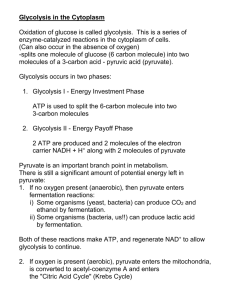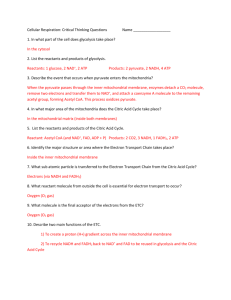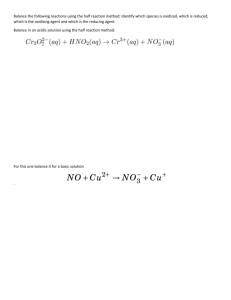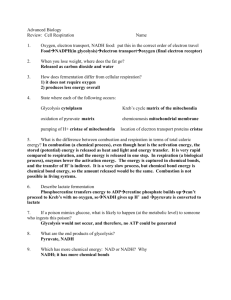Pyruvate - Lactate
advertisement
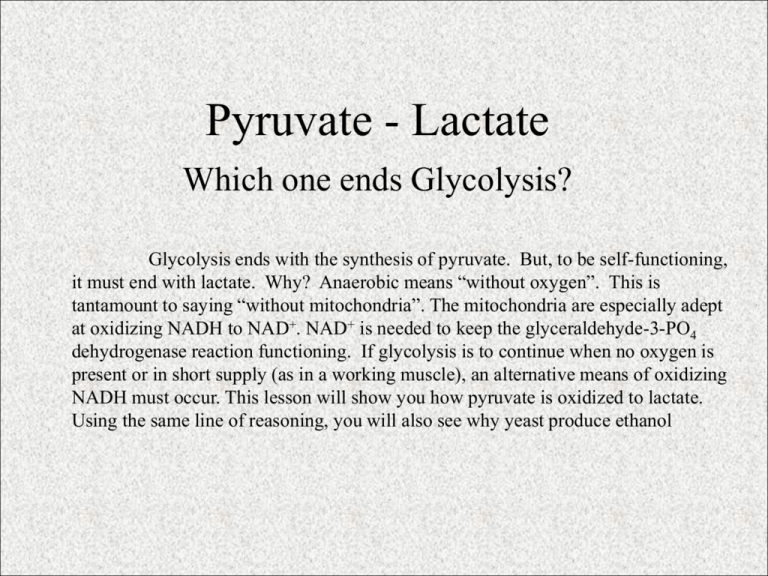
Pyruvate - Lactate Which one ends Glycolysis? Glycolysis ends with the synthesis of pyruvate. But, to be self-functioning, it must end with lactate. Why? Anaerobic means “without oxygen”. This is tantamount to saying “without mitochondria”. The mitochondria are especially adept at oxidizing NADH to NAD+. NAD+ is needed to keep the glyceraldehyde-3-PO4 dehydrogenase reaction functioning. If glycolysis is to continue when no oxygen is present or in short supply (as in a working muscle), an alternative means of oxidizing NADH must occur. This lesson will show you how pyruvate is oxidized to lactate. Using the same line of reasoning, you will also see why yeast produce ethanol By now you have seen the glycolysis pathway begins with glucose and ends with pyruvate (click 1). Pyruvate has 2 metabolic fates: it can either be converted into lactate (click 1) or to acetyl-CoA (click 1). Note that in animals and plants the electrons in NADH are transferred to pyruvate which reduces the carbonyl carbon in the pyruvate molecule to an alcohol. The reaction is catalyzed by the enzyme lactate dehydrogenase (click 1). Lactate (or L-lactate to be more precise) is thus a “waste product”, since it has no metabolic fate other than to be converted back into pyruvate in a reverse of the forward reaction. More importantly, the NAD+ feeds back to the glyceraldehyde-3PO4 dehydrogenase reaction, which allow glycolysis to continue. Were it not for lactate formation, glycolysis as a self-functioning pathway could not exist. Click 1 to go on. Glucose Glucose-6-PO4 NADH + H+ COOC=O Lactate Pyruvate Acetyl-CoA CH3 Pyruvate NAD+ COOHO-C-H Lactate CH3 dehydrogenase L-lactate In yeast a slightly different end of glycolysis becomes apparent. Yeast do not synthesize lactate. They do, however, oxidize NADH back to NAD+ anaerobically. How do they do this? The answer is they make ethanol. In the reaction the pyruvate is converted into acetaldehyde. The reaction is catalyzed by a lyase enzyme, pyruvate decarboxylase, which removes the carboxyl group as a CO2 (click 1). You should note that acetaldehyde is formed because the electron pair that bonds the –COO group is not removed by the decarboxylation (click 1). A proton is plucked from the environment giving the final product, acetaldehyde (click 1). Acetaldehyde is now the substrate that will oxidize NADH to NAD+ and in the process ethanol is formed (click 1). Can you name the enzyme that catalyzes this last reaction? Try, it, then click 1 to see if you picked the right one. Click 1 to go on. COO- CO2 C=O CH3 Pyruvate Pyruvate H NADH + H+ NAD+ H C=O Alcohol decarboxylase dehydrogenase Acetaldehyde CH3 CH2OH CH3 Ethanol There is another advantage to the pyruvate-lactate interchange. The reaction catalyzed by lactate dehydrogenase is reversible. This allows a cell to synthesize glucose from lactate (click 1). Converting lactate to glucose is a major feature of gluconeogenesis, an anabolic pathway that synthesize glucose from smaller precursors such as lactate. This is important because acetyl-CoA cannot be converted back to pyruvate and hence cannot be a source of carbons for glucose biosynthesis (click 1). Click 1 to go on. Glucose Lactate Glucose-6-PO4 Pyruvate Acetyl-CoA What did you learn. Click to find the answer. 1. You have seen that NAD+ is recycled back by oxidizing NADH. What other compound in the glycolysis pathway must be recycled to keep the pathway going. What reactions are connected for this compound? Click 1 for answer. ADP. ADP is required in the 3-phosphoglycerate kinase reaction and in the pyruvate kinase reaction. Its is formed from ATP in the hexokinase reaction and the phosphofructokinase-I reaction. 2. Yeast causes bread to rise (leaven) during baking. Bread rises because a gas is released during the baking. Name this gas and the reaction that gives rise to it? CO2. CO2 comes from the carboxyl groups of organic acids. Pyruvate decarboxylase catalyzes the decarboxylation of pyruvate releasing the carboxyl group as CO2. 3. Your textbook (p 406) discusses the “Pasteur Effect” and mentions that more glucose is catabolized with O2 present than in its absence. The Pasteur effect also pertains to an inhibition of ethanol production by allowing O2 in during fermentation (glycolysis). This in effect devastated the French wine industry. In effect, there is a competition between the glycolysis and the mitochondria for limiting substrates and coenzymes. What compounds are being competed for that could hinder ethanol production? NADH, ADP and PO4. This is a tough question, but it gives you a little more insight into the importance of NADH oxidation in glycolysis. NADH is converted into NAD + in the mitochondria. That reaction is promoted by O2 ; NAD+ stays in the mitochondria. Also in the mitochondria, ATP is formed by condensing ADP with PO4. Thus, O2 allows mitochondria to out-compete the cytosol for ADP, NADH and PO4, all limiting substrates or coenzymes. This shuts off ethanol production and turns wine into grape juice. As Louis Pasteur would say, “Sacre bleu” (oh darn!).


